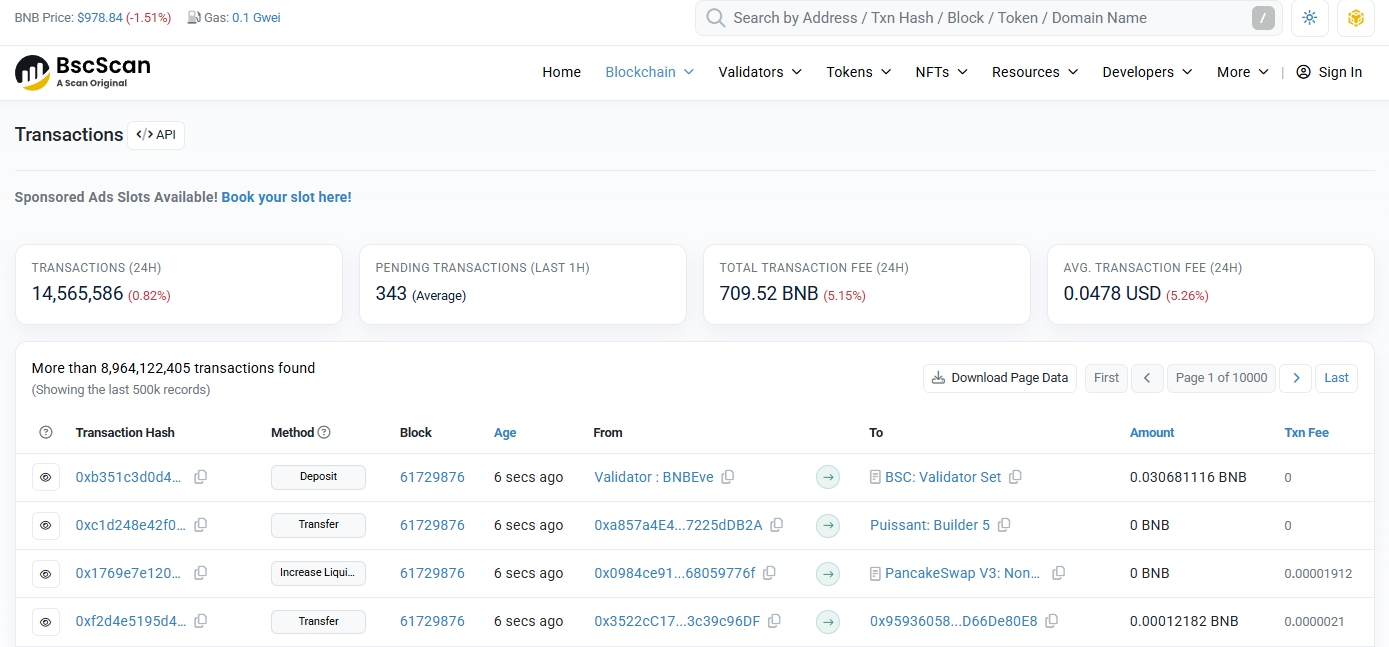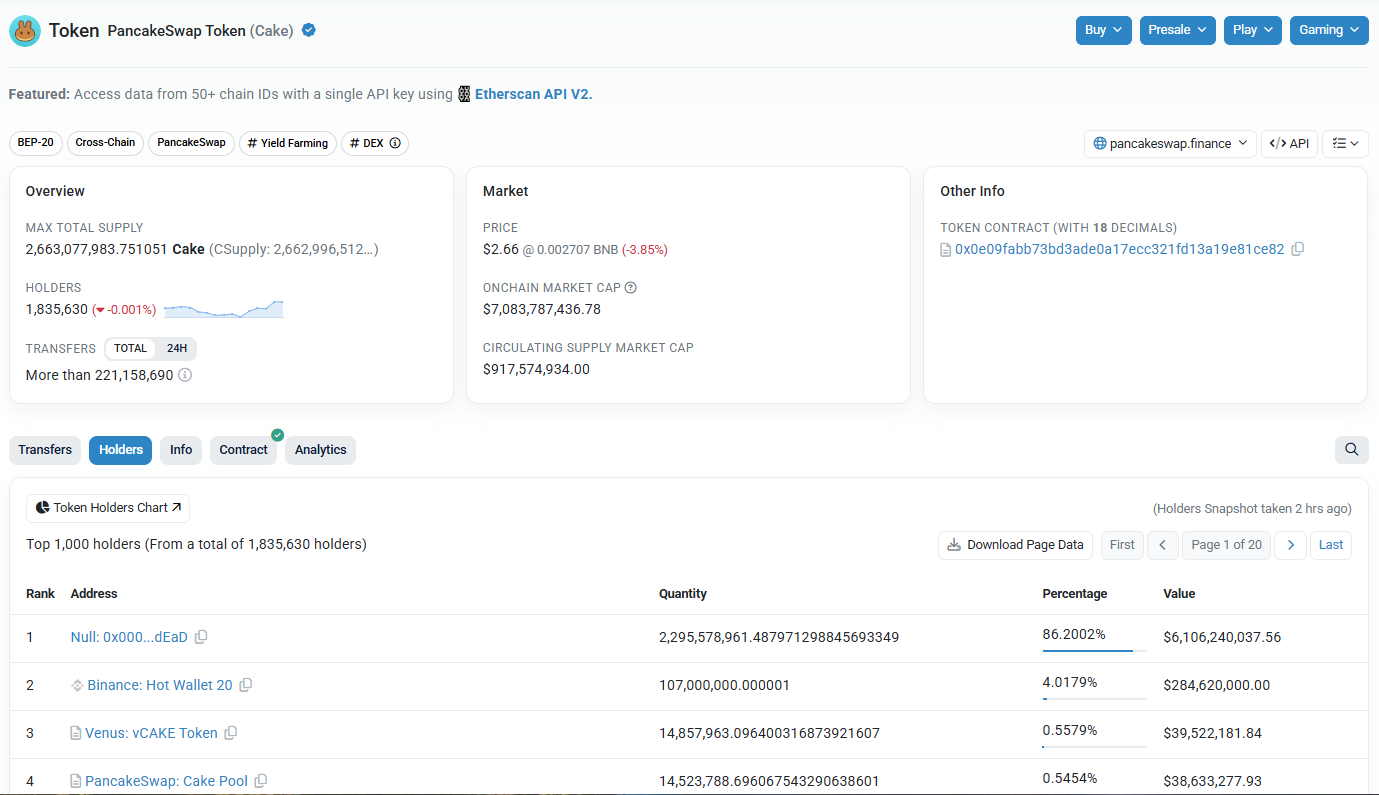What is BscScan and Why It Matters for BSC Users
BscScan is the primary blockchain explorer for the BNB Smart Chain (BSC). Think of it as Google for the BSC blockchain. It lets anyone search, verify, and analyze everything happening on the network. The platform was built by the same team behind Etherscan, led by Matthew Tan, and launched in 2020 when BSC started gaining traction.
Every transaction on BSC is public. But raw blockchain data is hard to read. BscScan solves this problem. It takes complex on-chain data and presents it in a clean, readable format. You don't need coding skills or technical knowledge to use it. The platform is completely free and doesn't require registration for basic features.
Review BNB Price on LBank
BNB() Prijs
De huidige prijs van BNB() is $0, met een wijziging van % in de afgelopen 24 uur en een wijziging van % gedurende de periode van Afgelopen zes maanden. Voor meer details kunt u nu de BNB prijs bekijken.
How BscScan Works as a Blockchain Explorer
A blockchain explorer is essentially a search engine for blockchain data. BSC records every transaction, smart contract interaction, and token transfer on its public ledger. This data exists forever on the blockchain. But accessing it directly requires running a node and understanding complex data structures.
BscScan connects to BSC nodes and indexes all this information. It then organizes everything into a searchable database. When you enter a transaction hash, wallet address, or token contract, BscScan instantly retrieves the relevant data. The platform updates in real-time as new blocks are added to the chain every three seconds.
The explorer doesn't store your private keys or control your funds. It only reads public information from the blockchain. This makes it safe to use for checking balances and transactions. You can browse anonymously without connecting a wallet unless you want to interact with smart contracts directly through the platform
Core Features Every BSC User Should Know
BscScan offers several essential tools for navigating the BSC ecosystem:
Transaction tracking forms the foundation of the platform. Enter any transaction ID to see its complete details. You'll find the sender and receiver addresses, the amount transferred, gas fees paid, and current status. The platform shows whether transactions are pending, successful, or failed. Each transaction includes a timestamp and block number for reference.
Wallet exploration lets you investigate any BSC address. View complete transaction histories, current BNB balances, and all BEP-20 tokens held. This feature helps track your own portfolio or analyze whale wallets and smart contract addresses. The platform displays both incoming and outgoing transactions in chronological order.
Smart contract verification builds trust in DeFi projects. Developers can upload their source code to BscScan for verification. The platform compiles the code and confirms it matches the deployed contract. Verified contracts show a green checkmark. Users can read the code directly and understand what the contract does before interacting with it.

Transaction Tracking (source: BscScan)
Advanced Tools for Developers and Power Users
BscScan provides sophisticated features beyond basic browsing. The platform includes APIs that developers can integrate into their applications. These APIs pull live blockchain data for prices, transactions, and network statistics. Developers get 100,000 free API calls per day with a registered account.
The gas tracker monitors network congestion in real-time. It shows current gas prices for slow, average, and fast transaction speeds. Users can see which contracts consume the most gas on the network. The tracker updates every 15 seconds during high activity periods. This helps traders time their transactions to minimize fees.
Smart contract interaction happens directly through BscScan's interface. Connect MetaMask or another Web3 wallet to read and write contract functions. This feature proves useful when a project's website goes down or seems suspicious. You can verify contract functions and interact safely through BscScan instead.
Token Analytics and Market Data

BEP-20 Token Analysis Example: PancakeSwap (CAKE)
The platform excels at token analysis. Search any BEP-20 token by name or contract address. BscScan displays:
- Current price and 24-hour changes
- Total supply and circulating supply
- Number of unique holders
- Top wallet addresses holding the token
- Complete transfer history
- Market capitalization when available
NFT tracking works similarly but with limitations. BscScan records NFT transfers based on ERC-721 and ERC-1155 standards. It shows ownership history and transaction details. However, the platform doesn't display actual NFT images or metadata. Users need to visit NFT marketplaces to see the artwork.
Data visualization tools help identify trends. Charts show token price movements, transaction volumes, and holder distribution over time. These visual representations make it easier to spot patterns and analyze project growth.
Comparison: BscScan vs. Etherscan
Since BscScan and Etherscan were built by the same team and serve a similar purpose, they share many functionalities but differ based on the blockchains they support.

BscScan vs Etherscan: Key Differences
Both explorers share the same development team and interface design. But they serve different blockchains with unique characteristics.
Network specifications differ significantly. BSC processes blocks every 3 seconds compared to Ethereum's 12 seconds. This means BSC transactions confirm faster. Gas fees on BSC typically cost cents while Ethereum fees can reach hundreds of dollars during congestion.
Token standards follow similar patterns with different names. BSC uses BEP-20 tokens while Ethereum (ETH) uses ERC-20. Both standards work the same way but aren't directly compatible. Projects often deploy on both chains with separate token contracts.
Decentralization levels vary between networks. BSC operates with 21 validators chosen through delegation. Ethereum has thousands of validators securing the network. This makes BSC faster but more centralized than Ethereum.
Ecosystem focus shapes each explorer's features. BscScan caters to DeFi traders and yield farmers who prioritize speed and low fees. Etherscan serves a broader ecosystem including NFTs, DAOs, and enterprise applications. Etherscan offers more advanced APIs and analytical tools for institutional users.
Security Best Practices When Using BscScan
BscScan itself is safe to use. But users must stay vigilant against common threats:
Always verify you're on the official website. Phishing sites create fake versions that steal login credentials. Bookmark the real site and double-check the URL before entering sensitive information. Look for the SSL certificate and proper domain spelling.
Never share private keys or seed phrases with anyone claiming to be BscScan support. The platform never asks for this information. All browsing happens using public blockchain data. Private keys stay in your wallet where they belong.
Research smart contracts before interacting with them. Check for verified source code on BscScan. Read the contract functions to understand what permissions you're granting. Unverified contracts pose higher risks. Look for audits and community reviews before connecting your wallet.
Be cautious with token contracts found through BscScan. Scammers create fake tokens with names similar to popular projects. Verify contract addresses through official project channels. Check holder distribution and liquidity before buying unknown tokens.
Real-World Use Cases for Different User Types
Traders use BscScan to track whale movements and analyze token distributions. They monitor large transfers between exchanges and wallets. Gas tracker data helps time entries and exits. Transaction history reveals buying and selling patterns of successful traders.
Developers verify their smart contracts and debug failed transactions. They use APIs to build portfolio trackers and DeFi dashboards. The platform's compiler helps test contract upgrades. Code verification builds user trust in new projects.
Investors research projects before buying tokens. They check holder counts, concentration levels, and transaction volumes. Smart contract verification confirms project legitimacy. Historical data reveals growth trends and red flags.
Regular users track their transactions and resolve issues. They verify token transfers arrived correctly. Failed transactions show error messages explaining what went wrong. Address labels help identify exchange wallets and known contracts.
BscScan: Pros & Cons

The Future of Blockchain Exploration on BSC
BscScan continues evolving with the BSC ecosystem. The platform regularly adds support for new token standards and contract types. Recent updates improved NFT tracking and added more detailed gas analytics. Mobile optimization makes the explorer accessible on all devices.
Integration with other BNB Chain products is expanding. BscScan now covers multiple chains in the BNB ecosystem. Cross-chain tracking helps users follow assets between networks. These improvements reflect BSC's growth beyond simple token transfers.
The explorer remains free despite increasing usage. No subscription tiers or premium features exist currently. This commitment to accessibility supports BSC's mission of affordable blockchain access. The platform generates revenue through API services for high-volume commercial users.
Educational resources within BscScan help newcomers understand blockchain technology. Tooltips explain technical terms. Documentation guides users through advanced features. These learning tools reduce barriers to entry for DeFi participation. As BSC grows, BscScan remains the essential tool for transparency, security, and education across the entire ecosystem.

